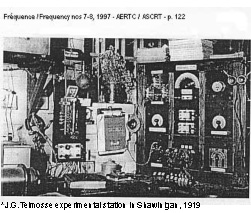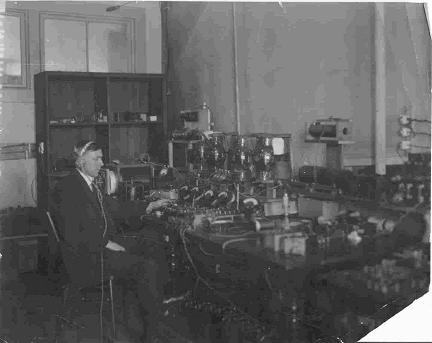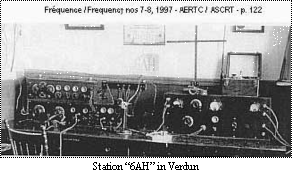
|
Spectrum Management - From the Early Years to the 1990s |
|
Page 04 of 26 The Radio Branch - The Early Days of the Service |
|
In 1910, the Radio Branch was under the direction of C.P. Edwards within the Department of Marine and Fisheries.
According to annual reports from the Department, its main activity was to provide facilities for communication with ships at sea and thus assist in their navigation and safeguarding of the lives of the people they carry.
The Branch owned and operated a number of coast stations and leased others to the Marconi Company. It was also responsible for licensing ship stations and examining operators for competency. Permanent inspectors were located at key ports for this purpose. The Branch also licensed and supervised commercial, experimental and amateur use of wireless apparatus.
According to government records, the first private commercial telegraph licences were issued to Goodyear Tire and Rubber Company for stations at Bowmanville and Toronto.
Canadian Explosives of Montreal also held a licence for a station on Bowen Island, British Columbia, for communication between the factory in Howe Sound and the Radio Branch station at Point Grey, which then forwarded the messages to the company's head office by conventional telegraph.
Thereafter, several lumber and oil companies in Alberta and British Columbia also obtained licences.
As early as 1909, a number of experimental licences were issued to army camps and, probably at the start of the war, to four radiotelegraphy training schools to train shipboard operators.
The Pachena station was reopened in 1910, but not without problems for the operator-in-charge, who found the building in very poor condition. He reported the situation, adding that it had been very difficult to reach the station, requiring a 10-mile hike over the Life Saving Trail from Bamfield through mud and snow while carrying two suitcases and a new antenna tuner.
The grounding of the SS Northwestern that went ashore on San Juan Island on December 3, 1910, resulted in an increase in the number of operators in order to provide 24-hour service.
In the fiscal year ending March 31, 1911, the first amateur radio licence was issued to Frank Vaughan of Saint John, New Brunswick.
By 1912, there were already 10 coast stations in Quebec, at Grindstone (Cap aux Meules), Clarke City, Grosse Isle (Grosse Île), Harrington, Heath Point, Fame Point (Pointe à la Renommée), Father Point (Pointe au Père), Quebec City, Three Rivers (Trois-Rivières) and Montreal, all with a range of 600 metres. In all, there were 38 coast stations and 51 ship stations as shown on an American list of wireless telegraph stations of the world (see the appendix). There were all sorts of call signs, with the letter "M" being used by Marconi stations.
Subsequent to the 1912 London Radiotelegraph Convention, Canada took action and corrected the issuing of call signs. The one for Pachina became "VAD".
At this conference, new radio services were created, such as the broadcast of time signals and weather reports that were assigned frequencies below 188 kHz. The range above 3 MHz was left free for radio amateurs because these frequencies were not considered usable at the time.
There was also the desire to encourage administrations to take measures to replace spark gap transmitters with vacuum tube transmitters, which were more stable.
After the Titanic disaster on April 14, 1912, national and international authorities became more serious about the safety of ships and passengers. The first International Convention for the Safety of Life at Sea was held in London in 1913. Vessels at sea would henceforth be required to keep a 24-hour radio watch on the frequency reserved for distress calls and communications. Fessenden also announced that he had received signals reflected by icebergs by radio, which had allowed him to measure their distance.
The Branch was transferred to the Department of the Naval Service in 1913, where it remained for the duration of the Great War.
At the beginning of the Great War (1914-18), there were already 95 radio amateurs in Canada, 16 of them licensed for receiving only, concentrated along the waterways in the Maritimes and Ontario, in Montreal (at the École Polytechnique), and on the west coast, especially in Victoria. They were quickly notified that they should cease operations immediately.
In October 1914, Marconi applied for a licence that would allow him to use the technology developed by Fessenden!
In 1914-15, 16 private commercial licences were issued, four were issued in 1915-16 and two more were issued in each of the following years. In July of the same year, an amateur from New Westminster, BC, Edward S. Brooks, applied for a licence to experiment with a "wireless telephone".
An experimental licence was also issued, with the call sign XWA, for a station installed at the Canadian Marconi plant in Montreal.
The first public commercial licence was issued for the Marconi station in Glace Bay, NS. After 1915, two more licences were issued to Universal Radio Syndicate, but the authorized stations in New Brunswick and Cape Breton never became operational.
It did not take long for the military to acquire radio instruments. Spark gap transmitters were available in 1916 and at the School of Signalling in Barriefield, Ontario, transmissions were permitted only between 7 a.m. and 7 p.m. to avoid interference.
Shawinigan 1919
In Shawinigan, in 1919, J.G. Telmosse participated in the wireless telegraph network organized around Georges Désilets in Nicolet, Dr. Honorius Ricard in Grand-Mère and Frère Germain Ouellet in Trois-Rivières.
In the 1920s, stations were also established by the Royal Canadian Air Force, which was responsible for forestry protection in Western Canada.
By the end of fiscal year 1920-21, there were six public commercial, 12 private commercial, 11 experimental and 581 amateur experimental licences, as well as a large number of coast and ship stations. The only telephone station was XWA in Montreal, although the Canadian Independent Telephone Co. of Toronto had also obtained a telephone licence in August 1920.
In Ottawa, the Branch had its own test room under the direction of E. David Hayman.
During this time, Director C.P. Edwards continued to visit his facilities across the country.
E. David Hayman at the new test room in Ottawa in 1920
Larry L. Reid, a former Department employee, wrote The Story of the West Coast Radio Service 1906-1956 and recounts a visit by Mr. Edwards to the Pachena station on the west coast in the early 1920s.
"In the early 20's the Director of Radio, C.P. Edwards, made a tour of the west coast stations and had to overnight at Pachena. On arrival there he was met with a delegation of wives who complained about having to use outhouses and urged the installation of interior facilities. Unfortunately they did not get much sympathy from Edwards who couldn't see anything wrong with outhouses and considered them healthy as you could relax in the fresh air while you meditated.
Unfortunately for him, however, that night he suffered a severe attack of diarrhoea and spent all night running back and forth through rain squalls to sit in a leaky outhouse. Afterwards he swore that his hostess had laced his dinner with laxatives. He must, however, have got the message, as shortly after, all the outside stations had indoor facilities installed."
In 1922, the Branch was already responsible for the operation and supervision of coast and direction-finding stations and marine beacons on both coastlines and along the Great Lakes, and for a considerable number of commercial, ship and long-distance stations.
It also handled the telegraph-traffic accounts for all commercial, government and international stations (to establish and collect transmission fees, the transmission cost was based on the number of words contained in the message).
The examination and certification of radio operators, and locating and dealing with radio interference were also among its responsibilities. (See the list of radio amateurs in Quebec from 1922 appended)
Changes to the Act resulted in the inclusion of radio broadcasting and related activities, such as licensing, wavelength and power assignment, inspection, and suppression of interference, not forgetting the collection of radio broadcast receiver licensing fees.
Because it was known from the outset that super-regenerative receivers were a major cause of receiver interference when they were tuned too close together, or close to the oscillation point, it was believed that Director Edwards had wanted receiver licensing in order to be able to compel receiving-set owners to modify their apparatus if necessary.
To a lesser degree than in the technical areas, the Branch was also involved in the regulation of the content of broadcasting messages: in ensuring that obscene or inappropriate material was not aired, in monitoring the wording of advertisements, and in controlling the use of pre-recorded material.
Until this point, "broadcasting" had been conducted mainly by holders of experimental licences.
In March 1922, the Branch instituted three new classes of licences: private-commercial broadcasting, public-commercial broadcasting and amateur radio. The first covered the broadcasting of commercial messages by station owners, the second covered the transmission of messages in return for payment, and the third was for low power radio amateur clubs and in areas with no other broadcasting facility.
The new licence classes were introduced on April 1, 1922, with call signs chosen in the CFA and CKZ series that had been reserved for British Dependent Territories by the international radiotelegraph authorities.
By the end of the month, 21 private-commercial broadcasting licences had been issued in Montreal (3), Toronto (6), Winnipeg (4), Regina, Calgary and Halifax (1 each) and Vancouver (5). In September, 47 were issued, and in December, 58 more, although many were never put into operation. All applicants received licences.
Due to the limited number of wavelengths (frequencies), mostly because they were already being used by American stations, and also because listeners did not want to choose between two stations on the air at the same time in the same city, i.e., to prevent interference between the stations, many licensed Canadian broadcasting stations were "phantom" stations, meaning that they did not have a transmitter. They used the facilities of other broadcasters and shared the time.
For instance, station CKCI, called "Le Soleil de Québec", used the CHRC transmitter. In Montréal, for some time, CFCF shared its wavelength for 12 hours of the week with CKAC. In 1927, CFCF shared with CKAC, CHYC and CNRM.
There were up to 19 phantom stations between 1923 and 1932 and in many cases more than two stations shared the same wavelength.
According to archived documents, the Branch's licensing policies and procedures during the years leading up to 1932 seem to have been ad hoc and even arbitrary, with virtually no written guidelines. Although certain priorities gradually evolved, they were liable to change at a moment's notice and frequently were not publicly known. There were also a few cases of political interference regarding the issuing of licences and decision-making within the Branch, according to M. Vipond.
In 1922, the (broadcast) receiving licence was introduced at an annual cost of $1.00. The need to demonstrate one's ability, be a British subject, or sign a declaration of secrecy in order to obtain a licence were dropped. In June, 2,588 licences were issued and by March 31, 1923, the number had reached 9,954.
The licence authorized a single receiver, and individuals who had several had to purchase a licence for each. The licence did not specify whether the station was fixed or mobile. Several years later, people wanting to be clever during the crisis and save money, modified their automobile receivers for use at home. Later on, the Department took this into consideration and changed the licences. (See Appendix)
Because the Radio Branch offered a number of services to receiving-set owners, with the receiver licence fee, the concept of user-pay was a hot topic.
It appears that there were also many 'unlicensed' sets. Divisional Superintendent E.J. Houghton of Victoria confided in a memorandum to his Director that he suspected as many as 25,000 sets were in operation in British Columbia, of which only 2,769 had been licensed in 1923-24.
Department statistics show that in as little as 11 years, the number of receiver licences went from zero to 600,000 and it was thought that between 20% to 40% of receiver owners did not have a licence for a number of reasons.
For a while, a share of the licensing fees collected was given to the consolidated fund of the Manitoba government for station CKY and to the Radio Branch to cover the cost of inspections, and locating and suppressing electrical interference at receivers.
In July 1922, the Department of the Naval Service was abolished and a number of activities were transferred to the Department of National Defence. The Branch returned to the Department of Marine and Fisheries and the workload increased with each passing year.
That same year, the Collège scientifique et commercial de Verdun, (which became Académie Richard), run by the Brothers of the Sacred Heart, obtained one of the seven training school licences issued in Quebec out of a total of 13.
The console was photographed in 1923, with the sign that identified the station by its call sign 6AH. (Ref: Fréquence/Frequency, Nos. 7-8, 1997 - AERTC/ASCRT - p. 122)
Station 6AH in Verdun, Quebec
In May 1923, at the request of the Manitoba government, the Radiotelegraph Act was amended to grant the province a broadcasting monopoly while leaving the federal government the task of legislating licences and assigning wavelengths. Manitoba was given 50% of the receiver licensing fees collected in the province, as well as the right to veto any new broadcasting installations in the province.
The same amendment also provided for the redistribution of some of the receiver licensing fees to the various broadcasting stations to help with their maintenance. Only Manitoba benefited from this provision in the Act. (This amendment was rescinded in 1932 because it was deemed to discriminate against the other provinces.)
In 1927, the Branch's clients could receive their correspondence in French.
As of 1922, the Department of Defence operated a communications network in western Canada for patrolling the forests. In the 1930s, this network consisted of a dozen land stations and several float planes equipped with radios in operation, with the main station being located in Winnipeg. The responsibility for natural resources was handed over to the Prairie Provinces in 1931.
During the same years, at the request of the Department of the Interior, the Royal Canadian Corps of Signals (RCCS) installed and operated a network of stations between Dawson City and Mayo in 1923, and installed and operated a second one between Edmonton and Fort Simpson in 1924. This network replaced a wire telegraph link that was very difficult to maintain, and over the years, several linemen died while on duty due to bad weather or bear attacks. In 1957, the government ordered the North West Territories and Yukon System (NWT&Y) radio station to be turned over to the Department of Transport.
In 1932, the Branch operated 29 coast stations, 12 direction-finding stations, 19 radio beacons, 4 radiotelephone stations and 47 ship stations, in addition to monitoring all the other stations.
No public-commercial licences were issued, but in 1932 there were still seven amateur broadcasting stations in operation for one or two hours a day in Ontario and Saskatchewan.
In 1931-32, over $500,000 were collected per year from receiving-set licence fees, representing 90% of the Branch's budget. (See the revenue table)
In 1935, the Temiskaming earthquake destroyed the quartz calibration support system used by the Ottawa measuring station. In a memorandum to W.J. Wilson, Ed Davey recounts the problems they encountered to rebuild the device. (See the chapter on monitoring stations)
In those years, and before the teletype service was installed, it appears that several broadcasting stations in Canada subscribed to it and received news bulletins in Morse code at 38 words per minute transmitted by the Press Wireless News Service, with call signs WCX and WJS.
In 1938, the certificates of proficiency in radio second class were issued by the Branch within the Department of Transport, but were granted by the Minister of Munitions and Supply as set out in the Radio Act in effect.
On September 5, 1939, C.P. Edwards, then Chief of Air Services at the Department of Transport, notified the amateur licence holders that their licences had been suspended forthwith and that they should dismantle and render inoperative all equipment. (See the appendix)
In March 1941, the North American Regional Broadcasting Agreement came into effect after several years of bitter negotiations where Mr. Bain's calculations were very useful for establishing forecast graphs for coverage and service area contours. Many stations were obliged to change frequency to comply with the approved plan.
The West Coast Radio Service operated until 1956 when it was amalgamated into the Telecommunications Branch under the Department of Transport.
References: 1- Mary Vipond, "Listening In: The First Decade of Canadian Broadcasting, 1922-1932" published by McGill-Queen's University Press. 2- National Archives of Canada 3- Pierre Poulin, DRP-R, Codification historique de la Loi 4- Military Communications and Electronics Museum 5- West Coast Radio Service - from the Web site of the West Coast Trail 6- US Department of the Navy, Bureau of Steam Engineering.
|
|
Spectrum Management - From the Early Years to the 1990s |








